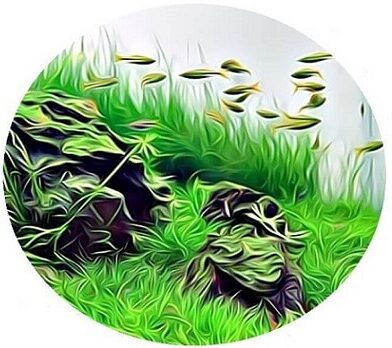How to setup a Freshwater aquarium
Well, we all know this story.
Time to buy an aquarium.
You go to the fish store, and you ask for help. The store representative starts to push you this device, that accessory, all those rocks options, small, medium, or large heaters, exceptional food to turn your fish a “rock star fish.” Glass tank, Acrylic tank!
Too many options.
Too many decisions to make.
Before you head to the store, you must know what is necessary; otherwise, you will buy things you don’t need, or you will need to return to the store later as something is missing.
How to Setup a Freshwater Aquarium?
Worst than that, three months later, you regret you decided to buy that small tank where you can have only two fish, and now you need a bigger one!
So what do you really need to buy at first when you are setting up an aquarium?
Is it worth buying a used fish tank?
What should I take into account when choosing the right location to put my aquarium?
What are the steps to set up new aquarium? How to start a fish tank?
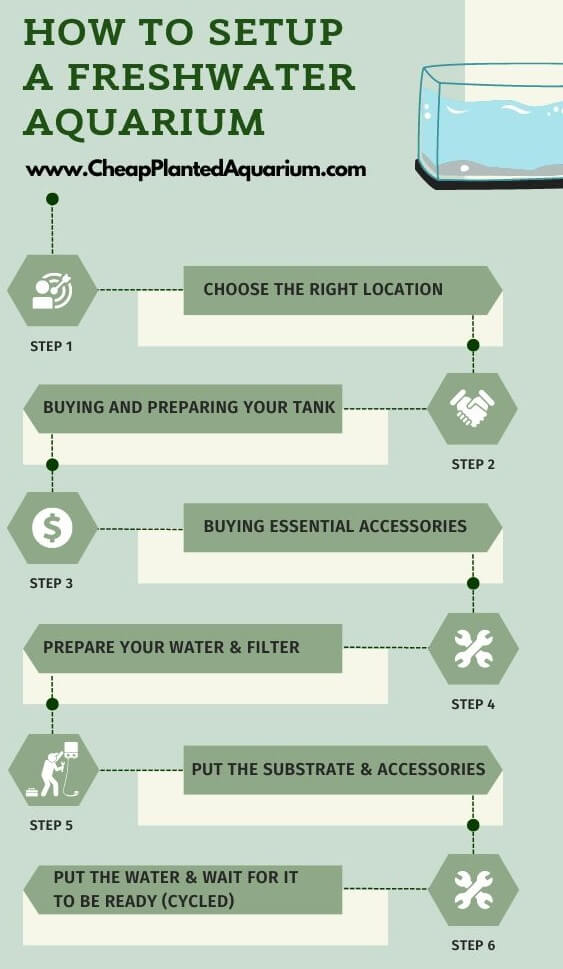
Choose the Right Location
A whole topic about choosing the right location to put your aquarium could look silly. However, remember that after you install your tank, put water and fish, it will be almost impossible to move it to another location.
Where is best place to put a fish tank in your house?
Do not put your aquarium where it will get direct sunlight, as the sunlight will sooner or later cause algae problems.
Believe me! Don’t do that.
The last thing you want is to fight against algae caused by sunlight.
Find a place with a power outlet close to it.
An aquarium full of water, sand, and rocks is heavy.
If you will use an old cabinet, consider using “heavy-duty leveling feet“ and install them before you put your tank in your cabinet. You can buy them on Amazon, Walmart, Lowes, etc.
Make sure your stand is leveled.
Buying and Preparing your tank
One of the first things that will come to your mind is to search for used aquariums on the internet or some neighborhood group.
I advise you only to do that if you know the previous owner.
Used tanks could come with scratches, cracks, or small imperceptible silicone leaks.
There are two things you will need to take into account when buying your tank.
The Tank Size
Fish tanks are listed in Gallons or Liters, which tells you how much water it holds. When you go to a fish store, you will see 10 gallons tanks, 25 gallons, 40 gallons, etc.
There are two reasons why you would need to plan a bit about the size of the aquarium you are going to buy:
- The amount of fish, shrimp, etc., you can have in your aquarium will depend on the tank size. The smaller the tank, the less fish you can have.
- Maintenance and fish health: although big tanks are hard to maintain, small ones are challenging. When the tank is small, many things go wrong very quickly, and you could have a lot of issues getting worse quicker than in a bigger tank.
I recommend you start with a tank between 10 and 20 gallons.
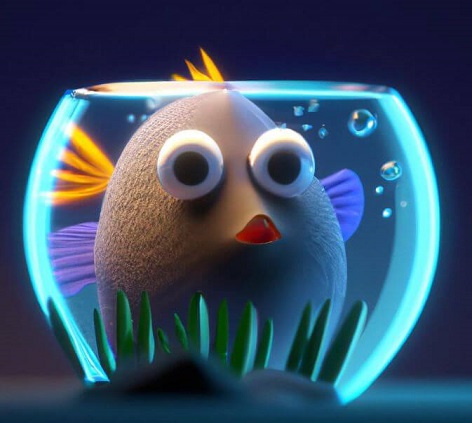
Check this article to learn more about Fish Tank Types and Sizes.
Side note: If you live in the US, Petco and PetSmart have excellent prices and sometimes a “1 dollar per gallon” promotion. I recommend you stop by one of these stores.
The Tank Material
Fish tanks are made with glass or acrylic.
I suggest you buy a glass fish tank.
A common question is how long do acrylic aquariums last. And about glass aquarium?
The average lifespan for a an acrylic aquarium is somewhere between 5 and 15 years if they’re properly maintained. A glass tank is 15 to 25 years.
Read more about Glass and Acrylic tanks here.
Preparing your tank
Before you install your tank in the final location:
- Do a small favor for yourself and put it in your garage.
- Fill it with water.
- Leave it there for 1 or 2 days to see if there is a leak avoiding surprises later.
If you have a braceless/rimless tank, having a mat under your aquarium is strongly recommended. Braced aquariums don’t need this mat.
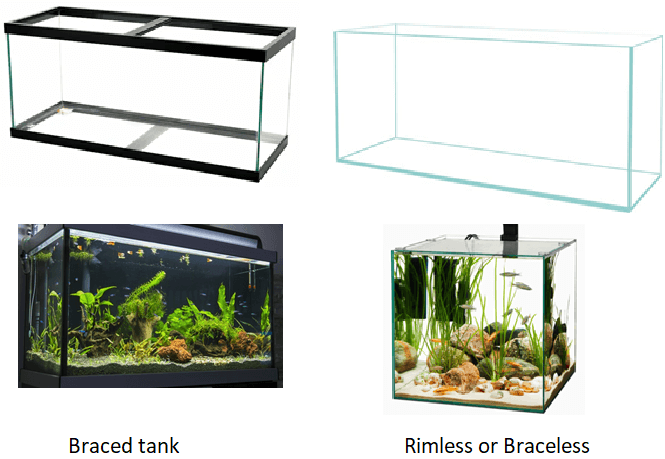
If you want something cheaper, go for polystyrene/Styrofoam sheets – the same ones kids use in school for science projects.
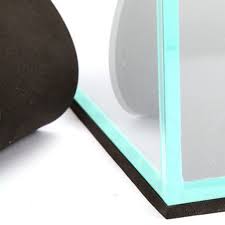
Buying the essential accessories
Water Filter
I suggest you start with a HOB filter as they are not expensive; you can accommodate different types of filtration media and implement mixed filtration methods (mechanical, biological, and chemical). Learn more about these three types of filtration methods in detail here.
There are four types of water filters.
- HOB Filters are the most common water filters. They are relatively inexpensive, efficient, and easy to clean. You can accommodate different types of media and implement mixed types of filtration.
- Canister filters are more expensive. They can be kept out of the tank and hidden in some box or behind it, making your tank and environment more pleasing.
- Sponge Filters are cheap and easy to use. I personally don’t like them as you can’t mix different kinds of filtration methods.
- Sump Filters are not so common in freshwater tanks.
Learn more about each one of them here.
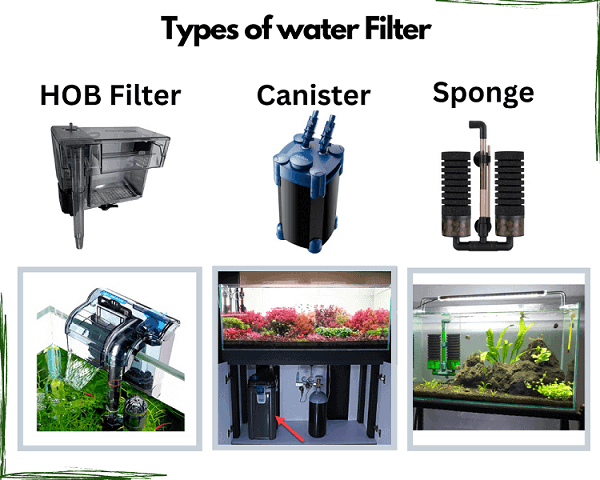
What to take into consideration when buying a HOB Filter?
- Buy a filter that is suitable for your tank water volume. If you have a 10-gallon tank, buy a filter for 10 or even more gallons.
- When you decide about the brand and model, research its noise level.
- Something nice to have as it will facilitate your life is a pre-filter like this one.
Water Heater
Air Stone
Water Test Kit
You must check the water’s pH and Ammonia levels occasionally (weekly in the beginning and monthly later when your aquarium water gets stable).
Buy at least these two water test kits right away.
Learn more about other water parameters as soon as possible. Check this article to learn about the ideal pH and Ammonia, what is considered a high ammonia level, and how to reduce it if needed.
Setting up your aquarium
Prepare your water
Our tap water has many unsafe chemicals for fish, snails, and shrimp.
Chlorine, for example, is added to the water to kill germs, bacteria, viruses, and other microbes. Chlorine is safe for us but very toxic to fish and other livestock, and you need to neutralize it (read more about chlorine here if you are interested).
So with that being said, you have two options:
- Buy distilled water from Walmart or other places (about $1 per gallon)
- Buy a “Seachem Prime Water Conditioner” to treat tap water.
A longer-term solution is to prepare your own water using a Reverse Osmosis (RO) Filter.
A RO device will purify your tap water.
A good and not expensive RO filter is the one from AquaticLife – it costs about ($70).
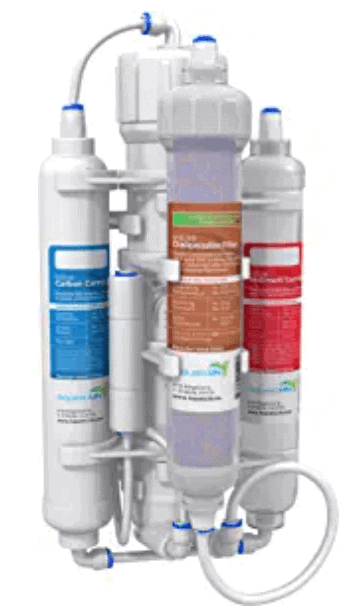
Check this article, where I explain Water Parameters and why it is crucial.
The substrate
We call substrate the layer of rocks, gravel, or sand in the tank’s bottom. You can have inert substrates (mainly for beauty), standard substrates, or active substrates (with minerals and other things that are good for plants, for example).
Using Gravel, Colored Rocks or River Rocks
Choose the one you like more but get smaller than 3mm if you plan to have shrimps.
Gravel or river rocks are perfect if you want a more natural tank.

Sand
If you like the visual sand gives, go for a swimming pool filter sand.
I recommend “HTH 67074” which you can find in Lowes, Walmart, Ace for about $15 25lbs). It is for sure a cheap aquarium substrate option.
I have it in 3 of my tanks as I love its visual.
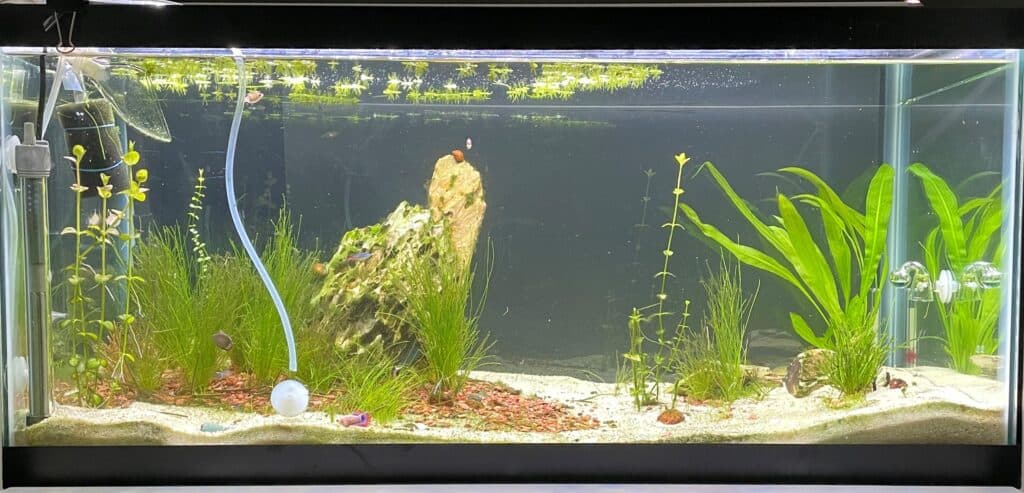
General remarks:
- Make sure you buy gravel, rocks, or sand that can be used in aquariums.
- Wash them with tap water 2 or 3 times before using them.
- Keep a layer of about 1 inch in the front and 3 inches in the back of the tank (suggestion only, not mandatory).
Putting everything together
- Put the substrate (gravel, sand, other) inside the tank
- Gently put the water into the tank
- Install the Water filter, Airstone and Heater
- Cycle your aquarium water making sure you will have enough good bacteria. Read more here.
- Replace 50% of the water
- Test your Ammonia level, and if it is close to zero, go get your fish. I suggest you to bring a little of your tank water to the fish stores so they can test it to ensure it is safe (they usually don’t charge you for this).
Start with 1 or 2 fish.
Don’t forget to acclimate your fish.
New Fish Acclimatization is crucial for the newcomers and the current aquarium inhabitants. Follow this step by step.
Wait a few weeks before you buy more fish.
Always measure your water quality, at least the pH and Ammonia (learn more here)
How much does an aquarium cost?
The cost o a freshwater aquarium ranges widely in price as it depends on the water filter, substrate, etc. For a 20-gallon tank, expect to spend about $100 to $200 US Dollars.
Read more here.
Side note: If you live in the US, Petco and PetSmart have excellent prices and sometimes a “1 dollar per gallon” promotion. I recommend you stop by one of these stores.
What is next?
Now that you have an aquarium, I suggest you read this article, where I explain what you should do when leaving the town on vacation (for example) or how to measure your water parameters.
